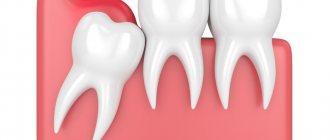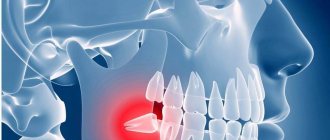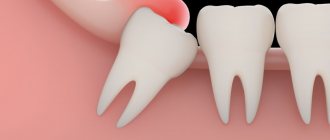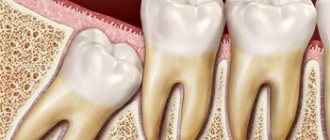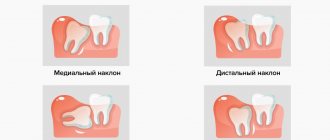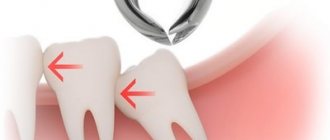For most people, the growth of wisdom teeth is accompanied not only by gum cutting and discomfort, but also by quite severe pain that makes it difficult to eat, concentrate on any task, and even sleep.
If the wisdom tooth grows and does not cause significant discomfort, no medical action may be taken. As a rule, the discomfort goes away after 1-2 weeks, but in order to avoid the manifestation of other problems, it is worth undergoing an examination at a dental clinic. However, if the gums from the wisdom tooth become inflamed, the local and general temperature rises, and specific aching pain is felt, immediately contact your dentist, he will conduct an examination and take the necessary measures to eliminate the problem.
Symptoms of wisdom tooth growth
During the period when a wisdom tooth comes in, a number of specific symptoms can be observed, by which it can be determined that the discomfort comes specifically from the eights:
- Discomfortable sensations in the tooth area, in some cases – gum thickening;
- Feeling of swelling in the gums;
- Increased local temperature, painful swelling;
- In the molar area, soft tissues (gums) become inflamed;
- Difficulty opening the mouth and swallowing. When opened wide, a sharp, aching pain is felt;
- There is a desire to chew any hard food or objects. After such chewing, the pain increases significantly;
- General increase in body temperature, general malaise and headaches.
Depending on the nature of growth, pain in wisdom teeth and specific symptoms can vary significantly. Regardless of how long a wisdom tooth grows - one or two weeks, it will cause certain sensations, and in case of complex or pathological growth - acute pain with inflammation of the gums.
An increase in general body temperature and swelling of the cheek indicates a severe course, as well as the possible development of pericoronitis - a complex disease of the oral cavity with a number of consequences.
Possible complications
Inflamed gums cause pain when chewing or swallowing, poor health and fever.
Pericoronitis is one of the serious complications that can occur during the eruption of third molars.
The disease is characterized by an inflammatory process that affects the tissue around the tooth.
Inflamed gums cause pain when chewing or swallowing, poor health and fever.
A characteristic feature of pericoronitis is the abundant proliferation of bacteria under the hood.
Around the third day, the disease becomes purulent. The patient complains of severe toothaches and pain radiating to the ear and temples, painful opening of the mouth.
The presence of pus under the formed hood causes intoxication of the body, which is manifested by high temperature. The patient has severe facial asymmetry on the side of the diseased tooth, pale face and inflammation of the lymph nodes.
Due to the proximity of the figure eight to the second molar, a small gap is formed in which food debris accumulates. The proliferation of bacteria in most cases leads to the appearance of caries.
A tooth that has already come out is considered the most convenient place for bacteria to multiply: its inconvenient location makes them difficult to clean. After some time, the gums become inflamed and swollen. Flux occurs with fever, severe pain and a swollen cheek.
When the upper tooth erupts, the trigeminal nerve may become inflamed, which is manifested by involuntary contraction of the facial muscles and sharp pain. With late therapy, facial paralysis may occur.
An abscess is a purulent disease that causes an unpleasant odor from the mouth, severe throbbing pain, a constant bitter taste and swelling.
The main causes of pain
Painful symptoms from wisdom teeth are caused by the anatomical features of the upper and lower jaw, which are already fully formed in a person at the age of 17-25.
As the figure eight begins to grow, it puts pressure on neighboring teeth, bone and soft tissue. The growth process can last for months and even years, so pain manifestations are temporary, periodically fading and exacerbating.
The pain of tooth 8 can be provoked not only by its growth or anatomically incorrect position, but also by the presence of various pathologies, for example, caries, pulpitis, periodontitis or a wide range of infectious diseases. Note! The lack of timely professional help can provoke a worsening of the situation, which will result in the need to remove the diseased tooth and treat complications.
When do the extreme molars erupt? How long does the process take?
The appearance of third molars depends on the characteristics of the human body. According to statistics, the eighth teeth grow between the ages of 17 and 25 years. The absence of signs of growth of extreme molars should alert a person and cause him to contact specialists.
After many X-ray studies, it became known that third molars begin to form at the age of seven.
The growth and duration of the process, in turn, depend on hereditary factors, the general condition of the body and the structural features of the jaw.
The physiological process takes from several days to a month, and sometimes even several years. Some people erupt all their teeth at the same time, while others by the age of forty have only one or no outer molars at all.
How to relieve pain if a wisdom tooth grows and your gums hurt.
The growth of wisdom teeth is not painless for every person, so most people need to know what to do in case of inflammation of the gums around the wisdom tooth and acute aching pain.
If there is inflammation, pain, or if the cheek is swollen near the wisdom tooth, you should contact your dentist, he will conduct an examination and take the necessary measures to eliminate symptomatic manifestations.
If the pain begins in the evening or it is not possible to quickly contact a specialized specialist, doctors recommend several ways to reduce pain:
- Rinse the growth with calendula tincture after eating - this will reduce the intensity of the inflammatory process and also reduce pain;
- Rinse your mouth with a solution of baking soda in water, at the rate of 1 teaspoon of soda per 1 glass of water (200 grams) - soda calms inflammation and also reduces pain;
- To rinse the mouth, you can use decoctions of chamomile, oak bark, chicory root, as well as sage tincture and propolis;
- Anti-inflammatory, painkillers and antibacterial drugs - use according to the instructions. They help reduce pain, reduce swelling, and also eliminate the negative bacterial influence at the site of tooth eruption.
In case of acute unbearable pain, as well as the absence of the above remedies, you can use cold water to reduce pain: take a glass of cool water, put a small amount in your mouth and hold it in the area where the wisdom tooth is erupting - this can quickly reduce the level of pain. However, this method has one negative feature - the pain intensifies almost immediately after stopping holding cool water at the site of gum inflammation, for example, near the hood of a wisdom tooth.
When are third molars removed?
There are a number of reasons why removing “eights” is necessary:
- incorrect direction of the tooth during growth;
- lack of space;
- change in the position of the teeth (crowding);
- strong pressure on the seventh molar;
- process of purulent inflammation;
- crown destroyed by caries.
In some cases, your doctor may advise you not to pull out your molars.
For example, if a patient undergoes dental prosthetics, during eruption they will take the correct position, and the canals are clearly visible for further treatment.
Where can I get dental care in Orenburg?
If your gums hurt where your wisdom teeth are, you can get qualified dental care in two places: public and private dental clinics. During the appointment, the dentist must:
- Conduct a preliminary examination of the oral cavity, determine the exact cause of the development of painful symptoms;
- If necessary, refer the patient for an x-ray - this procedure is often necessary in the presence of impacted wisdom teeth (completely or partially covered by gum), as well as in the case of surgical removal;
- Take the necessary measures to reduce or eliminate pain and swelling, as well as prevent further aggravation of the situation;
- If necessary, refer to a dental surgeon to remove third molars;
- Provide recommendations for further dental and oral care.
Do your gums hurt and you have symptoms of wisdom tooth growth? Seek qualified help from specialized specialists!
Consumer Reviews
Endge1305 (irecommend.ru)
“As I already wrote in my other reviews of means to fight for my favorite teeth, I have periodontal disease. And for some reason it is very aggressive, outdated, neglected. I don’t know why this bug has clung to me, but I’ve been suffering from it for a long time.
When I was young, it didn’t bother me at all, but two pregnancies and two breastfeedings meant that I lost a couple of teeth. Perhaps this would not have happened if my gums were in order.
And there was a threat that I would say goodbye to many more teeth, since the lower row of teeth acquired tartar, and the upper incisors were suspiciously very loose.
Attention! If your teeth have just started to become loose, take it seriously and see a periodontist. Fortunately, we still have free medicine and this service is also provided. It was there that the doctor prescribed me the Asepta Anti-inflammatory Gel for the treatment of periodontal disease.
It contains propolis, which is known to be a powerful anti-inflammatory natural antibiotic. My dad is a beekeeper, and I am closely acquainted with him (bee cud). I chewed it before, I liked its bactericidal effect. Sore throat, pain disappears. But propolis looks terrible on teeth. One day I went for a medical examination. It turned out that it was necessary to see a dentist there.
How ashamed I was to go to him, because not long before I had chewed propolis! My teeth were covered in this yellow gum that stuck like glue and couldn’t be removed at all! The specialist was quite surprised, but praised him for chewing propolis.
I knew that it helps against periodontal disease. But now I can’t chew - propolis apparently greatly increases immunity. Therefore, arthritis reacts to it and the joints become inflamed. This only applies to those people who have autoimmune disease.
If you prefer a civilized approach to dental treatment, you don’t need to chew anything like that, because the industry has already produced a medicinal gel based on propolis, which I’m writing about. Only the packaging is very small and there is a tiny amount of gel, namely 10 grams. They could have at least made a 50 gram tube.
But the manufacturer turned out to be too economical. Just imagine that the Doctor prescribed a periodontal treatment plan for me for 2 weeks. In this case, the product had to be applied to the gums at least 2 times a day. Of course, this quantity was not enough. I had to buy more packaging.
But many will not buy - most likely they will forget or regret the money. In general, I think that this is not convenient.
Anyway. It's on their conscience. The tube is sealed, I had to poke a hole in it with a needle. Inside there is a light yellow ointment that smells like bee products.
I did the procedures in the morning and evening as prescribed. I squeezed the gel onto my finger and applied it to my gums. I waited ten minutes.
It was just boring and unpleasant to wait, since it was impossible to swallow saliva. Again, propolis is harmful to me, and secondly, the product is not for oral use. The saliva accumulated and I had to endure it. You know this feeling yourself, right? And you can’t spit it out, because you’ll spit everything out from your gums, and swallowing it is also forbidden. Overall, it was fun. I don't think I lasted 10 minutes. I'll tell you straight, obviously not 10)
I don’t know, maybe some kind of cotton swabs should have been used to solve this problem. But I preferred to throw my head back and look at the ceiling in the bathroom, because you can’t really walk around the apartment with your mouth open...
..In general, the sensations from using the gel were pleasant. It is refreshing, there is a feeling that it is healing the gums. Next time I will look for a larger tube so that I always have a reserve and use it for prevention.”
katyushka237 (otzovik.com)
“The choice of drugs for oral diseases is not very wide. And, for the most part, they all contain two antimicrobial components: metronidazole and chlorhexidine. There may come a time when they stop working, due to microorganisms developing resistance to them.
This situation arose for me after undergoing gum surgery some time ago. The recovery period was quite long and I had to shorten it with the help of antimicrobial gels, which lost their effectiveness over time.
Therefore, quite recently, when a slight stomatitis appeared, I remembered the Asepta gel, which my doctor prescribed to me a long time ago and which I was not able to try at that time. The gel is available in two forms: with the above-mentioned metronidazole and with propolis. The second option turned out to be the most suitable for me and, accordingly, effective due to the presence of a natural antimicrobial component in the composition.
The gel is available in an aluminum tube and comes with an applicator. It is useless, since it cannot be used to apply the gel normally and a large amount of it is consumed. When applied, the taste of propolis is felt, in general, the taste is normal and disappears after about half an hour. The main thing, of course, is not this, but the effectiveness, which, compared to the above, is high if you carry out a course of treatment and do not give it up immediately after the symptoms disappear.”
